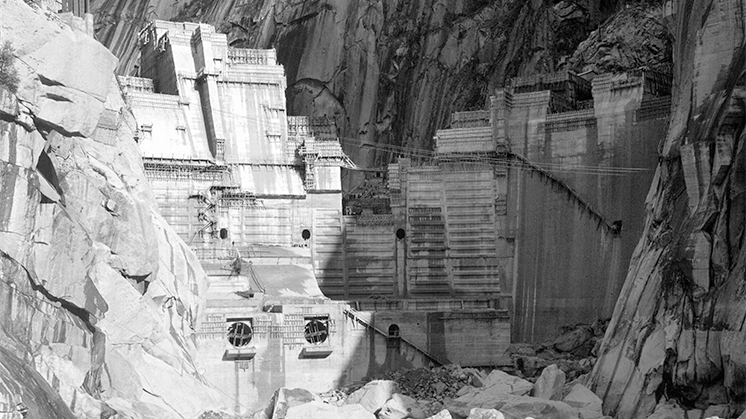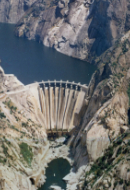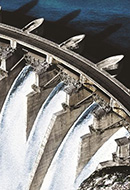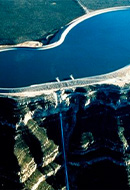Aldeadávila hydroelectric plant
Aldeadávila, a unique hydroelectric engineering project in Spain
Hydroelectric power Operating plants
The construction of the Aldeadávila dam more than half a century ago represented one of the most important milestones in Iberdrola's history in Spain. This hydroelectric facility, located in a canyon in the Arribes del Duero Natural Park in Salamanca, is one of the largest generators of renewable electricity in the country, enough to supply 733,000 homes.

Aldeadávila Hydroelectric Power Plant




The Aldeadávila hydroelectric power station, located in the impressive canyon of the lower section of the river Duero as it flows through the province of Salamanca, in the area known as the Arribes del Duero Natural Park, is one of the most important hydroelectric engineering works in Spain in terms of installed capacity and electricity production. This infrastructure is one of the largest electricity generators in Spain, as its production accounts for more than 8.5 % of the country's average hydroelectric generation, enough to supply 733,000 homes. It also saves the annual emission of 1.3 million tonnes of CO2 into the atmosphere.
The complex has two power stations: Aldeadávila I, commissioned in 1962 with a gross head of 139.80 metres, and Aldeadávila II, in operation since 1986 with a gross head of 137.83 metres. The former has 809.71 MW installed in six generator sets, while the latter has 432.93 MW with two generator-pump sets, making a total of almost 1,242 MW. Its average production is 2,400 GWh per year.
The Duero runs for almost 100 kilometres along the border between Spain and Portugal and winds its way between rock walls more than 400 metres high, which provides the optimum conditions for reservoirs and the production of this energy, which can be stored. The large flow that the river acquires at this point, together with the unevenness of this stretch of the Duero River, is what makes Aldeadávila the hydroelectric power station with the highest production in Spain.
Aldeadávila, one of the highest dams in Spain, is 139.50 metres high and has a crest length of 250 metres. It is capable of reserving 115 cubic hectometres in a surface area of 368 hectares, equivalent to almost 97 stadiums such as the Santiago Bernabéu (Madrid). The main structure of this facility is underground: it has 12 kilometres of tunnels.
Over the years, apart from its energy contribution, the reservoir has become one of the great tourist attractions of Las Arribes. Every year, thousands of people come to the area to admire one of the great engineering creations up close. Its spectacular viewpoint over the dam is particularly noteworthy, which can be reached by car from the village of Salto de Aldeadávila.
How does a hydroelectric power plant work?
Hydroelectric power plants convert the potential difference of water into electricity by transferring it between two points at different heights or elevations.

- Dam The dam across the natural river course holds back the water to form a reservoir. The potential energy of the flowing water is then converted into electrical output
- Water behind the dam flows through an opening and down a pipe called a penstock
- Potential energy is transformed into kinetic energy as the water flows through the pipes
- Turbine When it reaches the machine room, the water causes the turbine blades to spin, transforming kinetic energy into mechanical rotation
- Drain After giving up its energy, the flow of water drains downstream through a spillway
- Electricity generator The turbine shaft is attached to the electricity generator, which converts rotational energy into electricity
- Power lines
- Transformer
- Filtering grilles
- Pressure pipe
- Shaft
- Flowing water
- Water used for other uses such as irrigation
History of the Aldeadávila hydroelectric power station
Iberdrola's commitment to clean energy began with the construction of the Saltos del Duero, the hydroelectric project built in the border area of the river basin and located within the natural parks of Arribes del Duero, on the Spanish side, and Douro Internacional, on the Portuguese side. It was the engineer José Orbegozo who, after studying the river and glimpsing the entire canyon, realised the enormous possibilities it offered.
This project consisted of building powerful waterfalls that would take advantage of the falling water and create large reservoirs on the Esla Enlace externo, se abre en ventana nueva. and Tormes
Enlace externo, se abre en ventana nueva. and Tormes Enlace externo, se abre en ventana nueva. rivers. These installations would help to regulate the flow and guarantee the production of the powerful power stations to be installed downstream, which, along 110 kilometres of the course of the international section, had a gradient of 400 metres.
Enlace externo, se abre en ventana nueva. rivers. These installations would help to regulate the flow and guarantee the production of the powerful power stations to be installed downstream, which, along 110 kilometres of the course of the international section, had a gradient of 400 metres.

The construction of the Aldeadávila Dam is one of the most important milestones in Iberdrola's more than century-long history in Spain. Work began in 1956. In November 1962 the first machine was brought into service. In 1964 it was officially inaugurated with its six sets of 120 MW each, 720 MW in total.
Aldeadávila became the largest power station in Western Europe and doubled Iberduero's power, an achievement for the company and for Spain as it became a lever in the economic take-off of the 1960s and 1970s. In 1986, a new power station, Aldeadávila II, was inaugurated, with two sets of 210 MW each, raising the power of the plant to 1,140 MW.
Aldeadávila, a film set
This hydroelectric installation continues to surprise us with its grandeur and the place where it was built, in a steep area of granite rocks that has already served as the main backdrop for such well-known film productions as David Lean's Doctor Zhivago, one of the biggest successes in the history of cinema, winner of five Oscars and as many Golden Globes. Among the different scenes of the film, released in 1967, and shot in Aldeadávila, there is one in which the dam is seen emptying water.
Positive footprint: film sets (Spanish version).
The cinematographic adventure of the Salto de Aldeadávila continued with the filming of the Spanish film La Cabina, directed by Antonio Mercero and released in 1972. In this case, the setting was the underground galleries where Mercero depicted a kind of cabin rehabilitation factory in the final part of the film. There are also some scenes of the roads of the Poblado del Salto de Aldeadávila, which connect the Aldeadávila Park with the substation, as well as images of the entrance to the hydroelectric power station.
The hydroelectric power station of Aldeadávila was also the setting for Terminator 6: Final Destination, the sixth instalment of the saga, directed by James Cameron. The filming of the movie, released in 2019, involved the participation of nearly 200 people, twenty of whom belonged to the Salamanca town of Aldeadávila, hired for the preparation of the scenes and the filming. In addition, members of the Iberdrola hydroelectric plant staff participated as extras in the film.
In 2016, the dam also became the protagonist of the campaign that the Japanese company Fujitsu launched under the slogan The world is your workplace. The advert highlighted the freedom of working with its new laptop model, showing how four employees jumped from their office to the most striking natural landscapes in Spain, which they could access through the machine.
More recently, the Aldeadávila dam was chosen by the Salamanca designer Fely Campo as the setting for her debut at Mercedes-Benz Fashion Week -MBFW-, held in 2022 in Madrid. This space could be seen in all its splendour in the presentation of her luxury ready-to-wear collection. In 2023, the dam could also be seen in Fast and Furious X.
Iberdrola, world leader in renewable energies
At Iberdrola, we dare committed to renewable energy more than two decades ago as a fundamental pillar on which to build our safe, clean and competitive business model. Thanks to this vision, we are today world leaders in renewables, reaching 44,478 MW of clean energy in operation at the end of 2024.
This commitment is reflected in our Strategic Plan, in which we will allocate €15.5bn gross to renewables. More than half of this amount is focused on offshore wind in the US, UK, France and Germany; 28% on onshore wind and 18% on solar.

What is hydroelectric energy
Find out how hydroelectric power plants work.

Types of dams
There are different types of dams depending on their materials or mechanisms.

Hydropower terms
The 10 most relevant concepts in hydropower.

Pumped-storage hydropower plants
Do you know what pumped-storage hydropower stations are used for?





